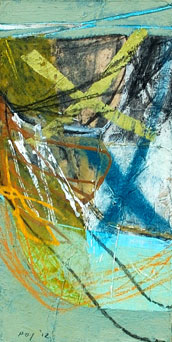A 'second looking' at Peter Joyce's recent paintings
A second look is more demanding than the first glance. It requires a little more thought and consideration. It usually offers more rewards too. If you offer 'Lost Path, le Marais de Lyarne' a quick look you will see texture, coloured tones and two crosses; one yellow and one blue. And that might be quite satisfying enough for one day. But that would also be a mistake, a diminishing of the opportunity afforded by this picture to collide with your day in a much more important way.
This tiny picture (and let us imagine the walk along the path that Joyce took in order to make it) has a dance at its core that is more psychotic and dervish than it will ever be pastoral. It has more psychology and philosophy than it ever will have representation. But you have to meet it halfway and collide with it rather than simply let it decorate your eyes for a moment. It has a serious intent. It may be a painting, but it is also a love poem and song; a comment on our presence in a place. See all of those lines; they are dancing with you and for you.
Or what about 'L'etier de l'echasse Blanche' or 'Tall Creek'? These upright and linear examinations of place are a journey of exploration; their shape and rhythm is all about movement. They ascend. The former is architectural with a central plank leaning leftwards from the bottom of the image over against the side wall whereas 'Tall Creek' is all loops and sideways oscillations. What are these oscillations? They are telegraph wires, they are the lines of bird flight and the tangled wire of an old fence but they are also the endless rhythm of a place defined by both man and nature. If you take these ingredients and make them into something else you are clearly performing the underlying alchemy of painting: you are telling your vision of the world through mark making. You are revealing yourself, and the way that the world continues to affect you, for others to experience. Again, if you meet the work halfway and take your experience to it, you will find it has a radical and rich intent.
A conversation can be short or long, intense or brief. 'Marais Breton Nord' is a long and serious conversation. Here the landscape is held in a wine glass funnel (the painting is structured like a vessel standing on a thin base) filled with more activity and imagination than can easily be contained. There are over thirty sections vying for your attention and interest: the obvious green 'w' below the beautiful blue pool is the start of the conversation. There are dark passages, flat (colour) moments and areas so overworked that the intensity of intent is palpable. In the middle the black lines have a chaotic staccato presence coming in and out of the white. Perhaps this core element is the central psychosis, a breaking through of the spirit.
'Exploring les Tendes' revisits the funnel shape over and over again; it is both the structure of the overall painting and the recurring cup motif, like tiles on a roof that fills the painting. It reminds us that the landscape is engineered to hold things (water, salt, and shellfish) but it also talks of the need to be held and to be contained. This is made evident not by the solidity of the multiple 'u' shaped cups but by the fury of the lines centre left that break over it and disrupt their efficiency. It is sensible to link the system of this landscape to the lives that inhabit it and to submit to the intense emotions this interaction creates. This radical painting invites you into the discussion.
Where does all of this 'second looking' take us? It takes us beyond the colours and the structures, beyond the real landscape and its carefully captured motifs and into a more unsettling place. As you walk into these paintings they walk towards you and generate ideas and concerns. There is madness and joy, indifference and calm, warmth and cold imbued in their colour, their intricately carved surfaces and their rhythmic insistence. These works are not decorative, they are sharp and unsettling. This collection of paintings, like a hand bound volume of poetry, is not designed to be easily digested with a single glance. A 'second looking' is a serious commitment.
Gary Topp
March, 2013
